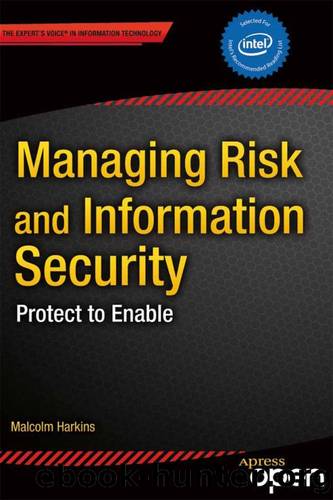Managing Risk and Information Security by Malcolm Harkins

Author:Malcolm Harkins
Language: eng
Format: mobi, epub
ISBN: 9781430251132
Publisher: Apress
The Security Benefits of Personal Use
When it comes to technology consumerization, information security specialists tend to focus on the security risks. As I discussed earlier in the book, we’ve found that the productivity benefits easily outweigh the risks. But even the security implications are not as one-sided as they might seem at first glance. I believe that, in some respects, allowing personal use may actually encourage better security.
In general, people are likely to take better care of their own possessions than someone else’s. They feel a stronger connection to their own car than to one provided by their employer. If people are using their own computing device, they may take better precautions against theft or loss. And they may feel the same way if they are storing personal information on a corporate device. At Intel, we allow reasonable personal use of corporate laptops, and therefore many employees store personal as well as corporate information on their laptops. Because of this, they have a personal stake in ensuring the devices don’t get lost or stolen.
I believe this sense of ownership contributes to our lower-than-average laptop loss rates. And recently, another company’s experience provided some empirical evidence supporting this idea. The company conducted a computing tablet pilot deployment in which, for the first time, it allowed personal use of corporate devices. At the end of the pilot, the company found that breakage and loss rates were dramatically reduced compared to its past experience with mobile devices. The CIO’s conclusion was that employees simply take better care of devices when they use them for personal purposes. Due to the lower loss rates, the company saved money.
It may also be worthwhile to reexamine other assumptions about the security implications of personal devices. Some companies have policies forbidding the use of cameras in their offices. However, a smartphone includes a camera that employees can use to capture the off-the-cuff design sketches often scrawled on whiteboards during brainstorming sessions. This intellectual property can then be stored on a hard drive within the enterprise and encrypted. Is it safer to allow employees to photograph the image, or to copy it onto a piece of paper, or to leave it on the whiteboard where anyone might see it? Companies may come to different conclusions, depending on their culture and appetite for risk. But this is another illustration of the importance of considering all the possible business benefits, as well as the risks when making technology decisions.
Download
Managing Risk and Information Security by Malcolm Harkins.epub
This site does not store any files on its server. We only index and link to content provided by other sites. Please contact the content providers to delete copyright contents if any and email us, we'll remove relevant links or contents immediately.
Grails in Action by Glen Smith Peter Ledbrook(9163)
Sass and Compass in Action by Wynn Netherland Nathan Weizenbaum Chris Eppstein Brandon Mathis(8808)
Azure Containers Explained by Wesley Haakman & Richard Hooper(7440)
Configuring Windows Server Hybrid Advanced Services Exam Ref AZ-801 by Chris Gill(7431)
Kotlin in Action by Dmitry Jemerov(7263)
Running Windows Containers on AWS by Marcio Morales(6980)
Microsoft 365 Identity and Services Exam Guide MS-100 by Aaron Guilmette(5398)
Microsoft Cybersecurity Architect Exam Ref SC-100 by Dwayne Natwick(5208)
Combating Crime on the Dark Web by Nearchos Nearchou(4978)
The Ruby Workshop by Akshat Paul Peter Philips Dániel Szabó and Cheyne Wallace(4667)
Management Strategies for the Cloud Revolution: How Cloud Computing Is Transforming Business and Why You Can't Afford to Be Left Behind by Charles Babcock(4527)
Python for Security and Networking - Third Edition by José Manuel Ortega(4232)
The Age of Surveillance Capitalism by Shoshana Zuboff(4209)
Learn Wireshark by Lisa Bock(4114)
The Ultimate Docker Container Book by Schenker Gabriel N.;(3886)
Learn Windows PowerShell in a Month of Lunches by Don Jones(3681)
DevSecOps in Practice with VMware Tanzu by Parth Pandit & Robert Hardt(3565)
Windows Ransomware Detection and Protection by Marius Sandbu(3540)
Blockchain Basics by Daniel Drescher(3507)
